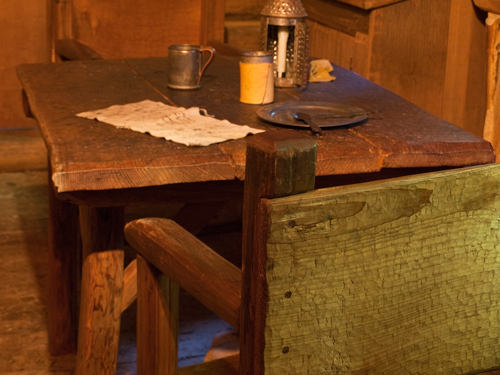The illnesses at Fort Clatsop may have been influenced by depression.
Captain’s Quarters
Fort Clatsop (replica)
© 2010 by Kristopher K. Townsend. Permission to use granted under the Creative Commons Attribution-Share Alike 4.0 International license.
The rainy weather, monotonous diet, and crisis over the lack of basic materials to carry out a routine bucking, wet scraping, and brain tanning of hides for clothes, combined with the fact that they had all been more or less sick since before day one, must have deepened their depression. Captain Lewis was disposed to conceal his own symptoms, but Clark was more inclined to tell all.
On 6 January 1806, a week after the fort was finished, Clark set out with 12 men, Sacagawea, and her 11-month-old baby to go and see the beached whale at NeCus’ Village. It involved climbing up and over “Clark’s Point of View,” now known as Tillamook Head, which he considered “the Steepest worst & highest mountain I ever assended.” In the steepest stretches they pulled themselves up hand-over-hand by the bushes—bushwacking. It felt like a 1,500-foot climb to him, although it was only a 1,000-foot drop over the sheer face of it into the Pacific surf. After collecting some whale oil and blubber they were ready to retrace their steps, but Clark had to admit to himself, “I am very pore & weak for want of Sufficient food and fear much that I shall require more assistance to get back than I had to get to this place.” But never mind, he consoled himself, “a deturmined [persistance?] will as it has done carry me through.” It did. Besides, he rhapsodized, “the nitches and points of high land which forms this Corse for a long ways aded to the inoumerable rocks of emence Sise out at a great distance from the Shore and against which the Seas brak with great force gives this Coast a most romantic appearance.” Remember, of course, “romantic” was an 18th-century euphemism for “wild, irregular.” Unimaginable.[1]Noah Webster (1758-1843), A Compendious Dictionary of the English Language (Boston, 1806), s.v. “romantic.”
Two months after they finished the fort, Lewis measured their predicament in simple arithmetic: “[W]e have not had as ma[n]y sick at any one time since we left Wood River.” The general complaint seemed to be “bad colds and fevers, something I beleive of the influenza,” as Clark put it. In fact, malnutrition must have been chiefly to blame, notwithstanding the sympathy of their Clatsop neighbors.
Lewis and Clark and all their contemporaries were totally unaware of the true identities, causes, symptoms and effects of most of their illnesses. Their digestive systems would have been assailed by a variety combative toxins such as Staphylococcus aureus (not discovered until 1880) and botulism (Clostridium botulinum, first recognized in 1895), as well as bacterial infections such as salmonellosis (formally identified in 1900), which is zoonotic (carried by animals, whence it can be transferred to humans through contaminated foods). Most cases of “food poisoning” have similar symptoms, including vomiting, diarrhea, fever, and stomach cramps, but health care providers such as Lewis and Clark who, according to military orders, were responsible for the care of their men, were instructed by authorities such as Benjamin Rush, M.D., to treat them with purgatives compounded with some form of mercury such as calomel—itself a potentially fatal poison—and various extremes of blood-letting that compromised normal resistance to infection. The ancient principle, Primum non nocere, “first, do no harm,” was known but still lacked the underpinnings of scientific research, discovery and application that would begin to emerge by the end of the 19th century.
Three months later, on the 6 March 1806, Clark would acknowledge that the convalescents still were “recovering Slowly in consequence of the want of proper diet, which we have it not in our power to precure.” Five days later, however, fortune smiled on them all when Sgt. Pryor bought from the Cathlamets—”for a very Small part of the [trade] articles he had taken with him,” according to Clark—”a Small Canoe loaded with relatively fresh fish.” Captain Lewis was elated. “[W]e once more live in clover,” he beamed with a sigh. “Anchovies [eulachon], fresh Sturgeon and Wappetoe [wapato].”
Notes
| ↑1 | Noah Webster (1758-1843), A Compendious Dictionary of the English Language (Boston, 1806), s.v. “romantic.” |
|---|
Experience the Lewis and Clark Trail
The Lewis and Clark Trail Experience—our sister site at lewisandclark.travel—connects the world to people and places on the Lewis and Clark Trail.
Discover More
- The Lewis and Clark Expedition: Day by Day by Gary E. Moulton (University of Nebraska Press, 2018). The story in prose, 14 May 1804–23 September 1806.
- The Lewis and Clark Journals: An American Epic of Discovery (abridged) by Gary E. Moulton (University of Nebraska Press, 2003). Selected journal excerpts, 14 May 1804–23 September 1806.
- The Lewis and Clark Journals. by Gary E. Moulton (University of Nebraska Press, 1983–2001). The complete story in 13 volumes.


